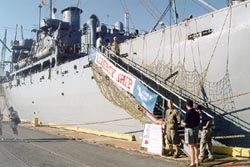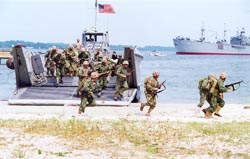 Boat Rides on the Bay
Boat Rides on the BayTurning Back Time on John W. Brown
 Boat Rides on the Bay
Boat Rides on the Bay
Turning Back Time on John W.
Brown
by Mark Burns
photos by Mark Burns 'Most of the crew would qualify as ancient mariners.'
Wandering the decks of the restored World War II Liberty ship John W. Brown on an August day in 1999 might lead you to believe some ripple has distorted the space-time continuum.
Sailors roam about in World War II uniforms listening to '40s' music spilling from antiquated loudspeakers while hundreds of retirees stalk about with cameras and camcorders. Abbott and Costello stroll on the main deck, passing by water bubblers and fiberglass latrines. At one point, the din of warfare rages as Brown's Armed Guard defend against a Japanese fighter and dive-bomber. Unruffled, people line up on the next deck down for the last scraps of a catered lunch set up near the museum exhibits and gift shop.
Such incongruities and more greet passengers on the regular cruises of John W. Brown, which makes several Chesapeake Bay voyages each year from its home port of Baltimore. A cruise on August 6, the third this year, draws 400 people for a one-way jaunt to Solomons; not a sell-out for a ship that fits 600, but still a grand showing.
On board, proud veterans of similar ships show wives, kids and grandkids what the old man used to do. Tourists peer through the sights of 22mm cannons and kids tuck their heads into vast steel helmets. Most passengers, at some point, slip below to gawk at an impressive 140-ton, 2,500-horsepower steam engine nearly three stories tall (think Titanic on a slightly smaller scale). The engine room's searing heat is enough to make wire-rimmed glasses hot against the face and the unmuffled machinations mute even the loudest attempt at conversation.
A big engine for a big boat. The Brown measures 441.5 feet long with a beam of nearly 57 feet. Its 8,500 tons of cargo space can hold 300 railroad boxcars. Unusual among Liberties for its firepower, the Brown boasts one five-inch cannon, three 3.25-inch cannons and six 22mm cannons.
The three guns at the bow - two 22mm and one 3.25-inch - get a workout in the mock battle with Japanese aircraft speeding in and out of range with two American fighters giving chase. From the crowd you can pick out the former gunners; they're the older gentlemen who appear unfazed, if not unimpressed, by the loud pops of cannons modified to use propane and spark plugs rather than shells. These are mere popguns compared to the thunderous reality they knew. "We didn't have earplugs," explains volunteer crewman John Komfair, 74. "That's why a lot of us say 'huh?'"
Old Ship
Needless to say, modern life aboard the Brown is a shadow of its excited past. Occasional Bay-bound cruises and immobile tours at the dock are all that now fill the days of the ship, itself a salty veteran of seven wartime supply runs to North Africa and Europe plus the invasion of southern France.
She was built in only 42 days and plunged from Baltimore dry docks into the Patapsco River on Labor Day, 1942 - one of 2,700 Liberty ships built during the war. Retired in 1946, she spent 36 years as a school ship in New York City before eventually coming home to Baltimore in 1988 where she was rehabilitated by 1991. Now her popular cruises sell out weeks in advance and draw people from around the world.
The Brown's voyages are truly rare; she only does a few trips each year and is one of only two Liberties left running (the other is the Jeremiah O'Brien in San Francisco). But when she does sail, she goes all out with live entertainment, vibrant living history by period-trained servicemen and, for guests, almost free rein of the most interesting parts of the ship. The crew also makes a habit of pausing halfway through each cruise to hold a somber memorial service; after a benediction, crewmen lay a wreath in the water, sailors in historic uniforms fire a 21-gun salute and a lone trumpet plays taps for an emotional conclusion.
Ancient Mariners
The Brown's resurrection as a link to the sacrifices and service of the Merchant Marines and the Navy's Armed Guard - which manned Merchant ships' defenses - is thanks in no small part to Project Liberty Ship, a 21-year-old, volunteer-run, privately funded non-profit preservation group that draws largely off a pool of eager veterans who know the ropes of maintaining the ship and raising funds.
"Most of the people that come here would qualify as ancient mariners," says veteran oiler Bob Sears of his fellow volunteers. "I'm coming up on 72 and I'm one of the younger ones."
Most are old salts confirms project chairman Brian Hope, who says more than half the volunteers are veterans. Complementing the veteran crew are kids, family and middle-aged enthusiasts eager to climb aboard a big ship.
Thomas Redden, who commutes 190 miles from New Jersey to help out, is an enthusiast. He had been a distant supporter for years before he finally saw the ship for the first time last February.
"Boy, that first weekend was like stepping through a time tunnel into an old John Wayne movie," exclaimed Redden. "One look at that engine room was just fantastic, and I've been down most weekends since."
One of Redden's favorite parts of the job is listening to the war stories of veterans, like the engineer Blackie, who was sunk once by Germans and once again, as prisoner on a German ship, by Allies. And then there's Jack Rhodes, a good-humored ancient mariner of 76. Rhodes tells of how he was "shanghaied" from the regular Navy into the Armed Guard, then shanghaied into the amphibious forces for D-Day, where he was part of the first wave to hit Utah Beach. He thought he'd be getting out after that but instead found himself shanghaied to China and the invasion of Okinawa. Rhodes' stint aboard the Brown, however, is strictly voluntary. "It's a glorious time," he said.
Like Rhodes, everyone else in the veteran crew of Merchant Marines and Armed Guardsmen proclaim joy in their volunteerism for the camaraderie it brings and the chance to share their experience. Wandering visitors find them at every turn, eager to answer questions and share a few stories. The most enlightening part of the cruise is meeting and talking with these guys.
Abbot and Costello, in truth Joe Ziegler and Bill Riley, aren't bad either. The duo start off on their last rounds after finishing their stand-up act on the bow's impromptu music stage.
Solomons Stormed
The Solomons Bridge is easing into view now and an embarrassed man finally gets the nerve to ask a nearby woman to take his picture with a calendar girl-style painting of Brownie - Rosie the Riveter's naval counterpart - hanging from the aft gun deck. Now that the continental breakfast and buffet lunch have been cleared, the call to passengers goes out to visit the 'tween deck for ice cream. Some people have ceased wandering and look more introspective than inquisitive.
Seven hours after leaving Baltimore, the August 6 trip ends at Solomons with nary an incident, aside from the gangplank snagging a light pole on the pier and snapping it off. But the Brown is in fine shape. The tug that had been trailing behind the entire voyage now comes alongside and nudges the ship into place. With ropes moored and pole cleared, tourists disembark, board buses and head back to Baltimore after a quick stop in Solomons.
The next day, John W. Brown - by now a conversation piece among those who've seen it moored near the Solomons Bridge - finds a new audience as it rounds Point Patience to offload a full company of Marines and soldiers into landing craft for Solomons' second annual amphibious training reenactment. From boat and beach, spectators marvel at Marines storming the beach and laying waste to a simulated pillbox with grenades and satchel-pack explosives after the Brown's simulated cannon fire softened the target for them. Flame throwers do a thorough job of finishing up; from 40 feet the bursts radiate enough heat to cook a turkey. Behind the Marines arrive the Army's men, landing to take the next bunker down with just as much fervor.
Calvert County wouldn't mind if the U.S. Marine Corps Historical Company assaulted Solomons more often. The company's Gunnery Sgt. Thomas Williams, for one, likes the idea. He reports that by 2001 they'll have something put together with the County and John W. Brown for an annual event. "Each year, too, so it doesn't stagnate, we are looking at adding a new element, expanding the program," says Williams.
Good news for Project Liberty Ship, which certainly likes the exposure. But why not earlier?
Next year the Brown sails the Bay but once, on October 7. The rest of its cruising season is being spent up at the Great Lakes in Ohio, where 14,000 rivets below the waterline are being replaced in her next big restoration effort. Farther into the future, the Brown's headed downtown; Project Liberty Ship has bought land near the Baltimore Museum of Industry where they'll build a pier as a permanent berth.
The next cruise is planned for Sept. 4, $115 round-trip from Dundalk Marine Terminal. rsvp. For more details: 410/661-1550 · www.liberty-ship.com.
Editor's note: "Turning Time Back on John W. Brown" is the 2nd in our series of first-person experiences riding the big boats of Chesapeake Bay. Many are relics of fleets whose time has come and gone. Others are brand new.
Some of these boats were built for pleasure, some for work. None was built for harder work than the John W. Brown, whose job was shipping troops and supplies to the Allied Forces World War II effort.
Keep steaming, sailing and motoring with us.
| Issue 32 |
Volume VII Number 32
August 12-18, 1999
New Bay Times
| Homepage |
| Back to Archives |